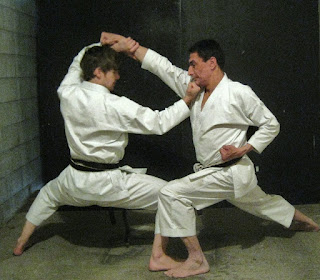by Phillip “Pete” Starr
My lack of understanding was more than a little obvious. He grasped my wrists and pulled them a bit towards himself. “These are weapons! Use them against your enemy!” I was still a bit confused. Didn't I need to protect myself; be concerned for my own safety? After all, my classmates weren't particularly concerned with controlling their blows when it came to practicing with the only non-Chinese person in the house.
I was still confused but I made it through class intact (which, one some days, was a real challenge). I sat at a small dinette table in my teacher's kitchen, sipping a glass of tepid water (he didn't like to drink cold water because he considered it unhealthy) as he tried to unscramble my brain. “Don't stop enemy's attack”, he said as he executed a series of brisk blocking movements. “When you do this, you give him another chance to hit you. Maybe you block the first and second attack, but he keeps attacking and soon he will hit you.”
“So when he attacks, I shouldn't...block?”, I asked. Now things were getting really confusing. “NO!”, he replied. “Do not block to stop his attack.” He raised his arms and hands into his fighting position. “If we fight, I only want to crush you. I don't think about myself. My mind is to you; my energy is to you, not to me.”
Okay. I was starting to get a handle on this. He explained that the arms are used either to establish a “bridge” between myself and my opponent, or to attack directly. He considered “bridging” a part of my attack; an entry for an attack. Actual direct blocking was another story. He motioned for me to touch his head and as I did so, he snapped up a sharp, focused block. I winced in pain and quickly withdrew my arm. “Block is for attack”, he explained. “Hurts enemy's arm, he stops for a second...this is when you strike him.” So “blocks” were also forms of entry. They weren't intended to simply prevent the opponent from hitting you.
This same concept was explained to me again many years later by Master Seiyu Oyata (10th dan, Okinawan karate). “There are no 'blocks' in karate”, he told me. “Block” is to attack your enemy's arm or leg. He made sure that I understood by having me execute various forms of attack. Each time he blocked, it was as though my arm or leg had been struck by a steel bar! A single block would have been enough to stop me in my tracks, which would give him ample opportunity to deliver a lethal counter-attack. His blocks weren't “muscled through” as if he was swinging a ball bat; they were focused and sharp.
My kung-fu teacher, Master Chen, preferred the use of “bridging”, which is done without much force and enables the practitioner to quickly enter his opponent's “defense perimeter” and control him long enough that a finishing technique could be quickly applied. Bridging is common in most kung-fu styles and is easily seen in southern forms such as White Crane, Southern Mantis, Dragon Boxing, and so on. It is also present in the neijia forms of taijiquan, xingyiquan, and baguazhang, although not necessarily as readily visible.
In speaking with Oyata sensei, I determined that using “blocks” as forms of entry/attack changed the rhythm of one's forms. He smiled broadly and nodded. In executing a particular karate kata, for instance, most practitioners perform the movements in a regular, steady rhythm...kind of like One (block, pause), Two (strike, pause), Three (block, pause), and so on. This doesn't train them to utilize the blocking techniques correctly.
Instead, it be something like OneTwo (block and strike immediately), Threefour (ditto)... it certainly changes how the kata feels! And learning to maintain a stable stance, correct body shifting, and all of the other elements of effective technique will take some time to learn. Oyata explained that this is how kata were intended to be practiced as opposed to “waltzing” through them like rhythmical dance steps.
My energy, Master Chen explained, was to be extended towards the enemy rather than withdrawn. The objective was, he explained, to strike HIM rather than withdrawing part of my mind and energy in worrying about myself. Miyamoto Musashi (renowned as the “sword saint” of Japan) said that when facing the enemy, one's sole objective is to cut him. Period. One's spirit, energy, and sword are directed towards the enemy, not withdrawn.
Most people, when they perform a movement that shifts the weight rearward or steps back, tend to withdraw their energy and spirit; they have little difficulty extending when the weight or movement is forward, however. This is an error. Regardless of where you shift your weight or step, the energy is to be constantly directed TOWARDS the enemy! There is no “retreat” (in fact, the use of that word is frowned on in the practice of yiliquan). There is withdrawing (because energy is still directed towards the enemy although an adjustment in the weight or movement is made) but there is no “retreat”, which infers a sort of running away from the enemy...giving him a fine opportunity to cut you down.
In kendo, for instance, higher-level practitioners can readily feel when you withdraw your energy or if your spirit wavers. At the instant they detect such a thing, they attack without hesitation. In a split second, the bout is over. It's the same in karate or kung-fu. Remember my teacher's words...”ENEMY OUT THERE!”






.jpg)





















No comments:
Post a Comment